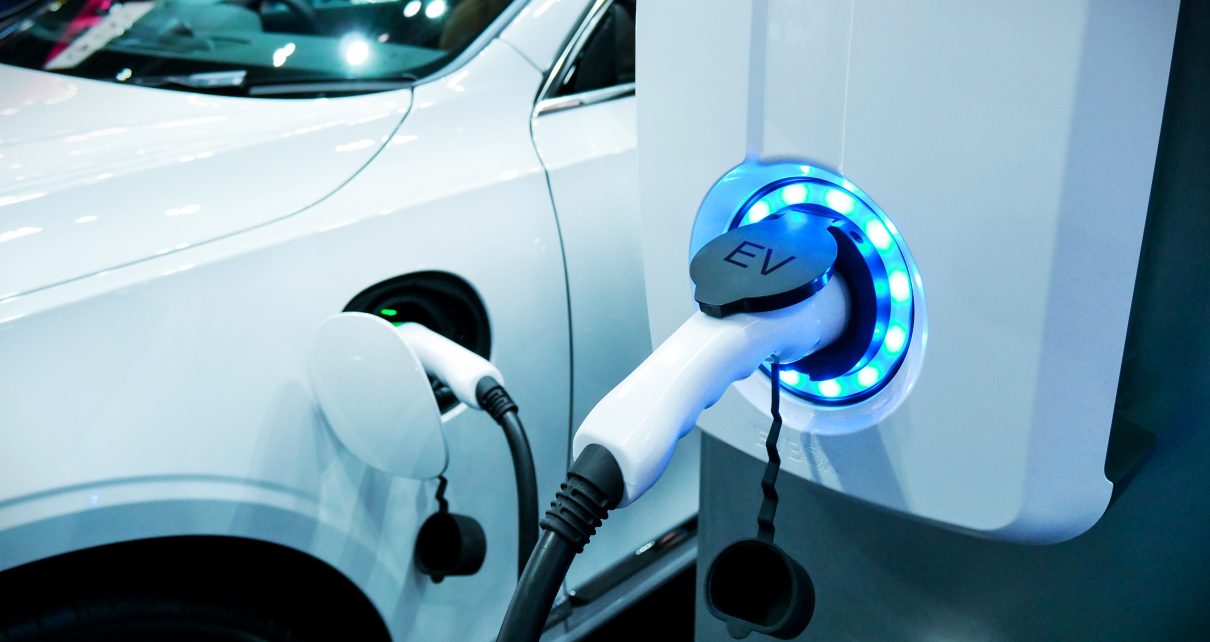
A power supply charging the battery of an electric automobile. (Photo: Shutterstock/buffaloboy)
Ringside: How Newsom Can Achieve ‘Affordability’
In the name of fighting the climate crisis, they’ve put 40 million Californians on the bleeding edge
By Edward Ring, December 18, 2024 4:38 pm
 Leadership in the California Legislature claim they’re aware of the cost of living and doing business in the state. In the special session called by Governor Gavin Newsom to “Trump proof” the state, Assembly Speaker Robert Rivas (D-Salinas) said, “We must chart a new path forward and renew the California Dream by focusing on affordability.”
Leadership in the California Legislature claim they’re aware of the cost of living and doing business in the state. In the special session called by Governor Gavin Newsom to “Trump proof” the state, Assembly Speaker Robert Rivas (D-Salinas) said, “We must chart a new path forward and renew the California Dream by focusing on affordability.”
We welcome this nonpartisan acknowledgement of what is the biggest challenge facing households and small businesses in the state. In that spirit, and for our final weekly newsletter of 2024, we shall reiterate ideas for how we believe affordability and economic health may be restored in California.
We may begin by ending the legislative assault on California’s oil and gas industry. Start permitting new drilling, repeal the 3,200 foot setback between wells and “sensitive receptors,” and repeal the most recent unreasonable regulations on refineries. These measures are hypocritical. California relies on oil and natural gas for 80 percent of its raw energy. Yet despite sitting on ample reserves of both, we import 75 percent of our oil and 90 percent of our natural gas.
California’s elected officials must recognize that while many electric applications convert raw energy into usable energy more efficiently than “thermal” solutions, it is going to take 50 years or more to further develop the technology and retool our entire infrastructure. Meanwhile, we should not be exporting the impact of our dependence on oil and gas overseas, when we can extract it far more responsibly right here.
The most difficult reality check for California’s elected officials, however, is the fact that infusing every law and regulation with “climate crisis” urgency is incompatible with affordability. Our major electric utilities, for example, cannot afford to rapidly transition to “renewables” at the same time as they must maintain their aging statewide grid of far flung transmission lines. As long as ratepayers have to subsidize both of these massive undertakings, electricity will cost more than twice what it costs in less ambitious states, and our big utilities will continue to flirt with bankruptcy.
A more reasonable strategy is to prioritize policies and projects that address climate change concerns but don’t go off the deep end. If they don’t make economic sense, find alternatives that will. One big step in that direction would be to replace the goal of “net zero by 2045” with reasonable goals for carbon intensity. Doing this would enable natural gas powered generating plants to remain part of our electricity supply, driving electricity rates down as the competing base of photovoltaic/battery systems continues to grow. Emerging designs for natural gas power plants offer efficiencies of over 70 percent. We should be building them here in California.
Another way to drive down the cost for electricity is to offer the same incentives (or lack thereof) – tax credits, subsidies, rebates, depreciation, etc. – to installers of photovoltaics and batteries whether they are gigantic utility scale systems or small private inside-the-meter systems on household rooftops and small business properties. According to an NREL study, California has over 10 billion square feet of usable rooftop space. Fully utilized, that could generate over 250,000 gigawatt-hours per year.
Similarly, California should implement an economic model whereby owners of EVs can fill their batteries with surplus electricity while parked during midday, then sell back to the grid during peak evening demand the amount of charge they aren’t going to need the next morning. This innovation, along with creating a level playing field for decentralized solar vs utility solar, eliminates much of the need for massive ratepayer subsidized utility investment in PVs, batteries, and transmission lines.
To help make transportation affordable, Newsom may withdraw his executive order restricting new vehicle sales to EVs by 2035. Instead, as noted, set reasonable goals for carbon intensity. This permits a natural evolution from gas to electric, allowing various pathways for advanced hybrid vehicle technologies to compete. We cannot foresee what technology may deliver in terms of more sustainable and better performing battery, transportation fuel, and combustion engine technologies.
More than anything else, deregulation is the path to affordability in California. We may start with CEQA reform, which more than any other single set of laws, paralyzes development in all sectors. We can also deregulate zoning, not only to facilitate “infill,” but also to enable more single family homes on open land. As it is, building permits, fees, codes, zoning, and other mandates have made it impossible for an unsubsidized developer to make a profit building affordable homes. This is not inevitable. It is a political choice.
If regulations make homes unaffordable in California, they’re making farming impossible. Here are some ways to bring back abundant irrigation water in ways that don’t raise taxes or harm the marine environment.
Permit Central Valley water agencies to adhere to “voluntary agreements,” a wholistic approach whereby flows into and through the delta are flexible depending on how successful overall efforts are in protecting threatened species. The alternative mandates an “unimpaired flow” of rivers into the delta regardless of whether or not that improves species survival. The unimpaired flows approach will take another million acre feet per year away from California’s farmers, and take away incentives to develop hatcheries, habitat, wastewater treatment, and predator control – all of which affect salmon and smelt as much or more than “unimpaired flows.”
Develop a legal framework allowing senior water rights holders to guarantee floodwater access to downstream property owners, so they will invest in aquifer storage. Currently unharvested floodwater in the San Joaquin Valley averages an estimated 700,000 to 900,000 acre feet per year.
Prioritize public works projects that are not only far less expensive if we can deregulate the permitting environment, but are compelling bargains no matter what. The Fish Friendly Delta Diversions proposal, promoted by the San Joaquin County Blueprint (a coalition of water agencies), is an example of such a bargain. At an estimated cost of $2-$3 billion, a 200-acre site in the central delta could withdraw 15,000 acre feet per day during winter storms.
Finally, repeal the laws implementing household water rationing. At an estimated cost of $7 billion, it will only “save” 400,000 acre feet per year. Worse, by limiting how much water urban water agencies can deliver to their customers, it removes their incentive to invest in more water supply and storage infrastructure.
More generally, California’s legislators need to reject megaprojects that utterly fail any rational cost/benefit analysis. The high speed rail project, already well underway, and the state’s plans for floating offshore wind farms, both promise to waste hundreds of billions that could be put to work on projects that would yield an ongoing economic benefit to all Californians.
Private investment in a regulatory environment that nurtures competition will bring down the price of energy in California. For water, redirecting public investment into cost-effective projects will guarantee a sustainable, resilient, abundant, affordable supply.
One of the ways California’s legislators want to “Trump proof” the state is to welcome and protect immigrants, the disadvantaged, and members of low income communities. They’re right that affordability is the key to helping the less fortunate. But they’re going about it in all the wrong ways. In the name of fighting the climate crisis, they’ve put 40 million Californians on the bleeding edge. The only beneficiaries are bureaucrats and special interests.
If Gavin Newsom, Robert Rivas, and the rest of California’s ruling coalition want to make California an affordable and welcoming state, and set an example the world is willing to follow, they’ll need to deregulate, redirect public funds out of boondoggles and into productive investments, nurture competition in ways that will challenge special interests, and step back from extreme environmentalism. Otherwise it’s all just talk.
- Ringside: Saving California’s Rural Water Users - May 8, 2025
- Ringside: How to Add 10 Million Acre Feet Per Year to California’s Water Supply - April 30, 2025
- Ringside: Can EVs Make Up for Gasoline Shortages? - April 23, 2025








What everyone needs to understand is that this is communism 101 – set everyone against one another and destroy the economy while blaming everyone and everything else for it, then in the ensuing chaos hijack the anger and seize total power while promising to fix everything. After all, happy, prosperous people don’t revolt while putting blind trust in psychopathic assholes. In the meantime the population centers have to be pissed off enough while correctly identifying the true source of their woes to effect positive change. Witness the French revolution and the Bolshevik revolutions in Russia circa 1917. Compare those with the American Revolution. In the meantime there needs to be a ballot initiative to restrict goobernatorial executive orders to a 2/3 vote in both houses of the legislature to be valid with a two month sundown.
It’s all about control. The goal is to take a million acres of the best farmland in the world; farmed by the best farmers in the world, out of production. Newsome declared a state of emergency because of bird flu. Somebody wants to kill all the cows and chickens. If you control the food supply you control the people.
Exactly. Newsom is a World Economic Forum globalist stooge who is implementing their demonic agenda while the criminal Democrat mafia in the legislature and his handpicked bureaucrats on nebulous agencies like CARB go along with it.
just read on X that Elon Musk is coming out with a car powered by water. Cool. Once that is in production, we don’t need to take away a million acres of farmland to power solar cells. Capeesh?
Affordability? Do the EXACT opposite of everything Noisome says, Easy !
Demonstrate a “water fueled” production model that is affordable to people pummeled by the Biden/Harris economy, is reliable, has a 350 mile range without refueling, easy and affordable to maintain, and is ready to go after 7 minutes of refueling. Other than that, it is all speculative bullshit. And, we have never had to “take away a million acres of farmland to power solar cells,” that nonsense is from leftists who wilfully work to engineer both a famine and economic collapse. Capiche?